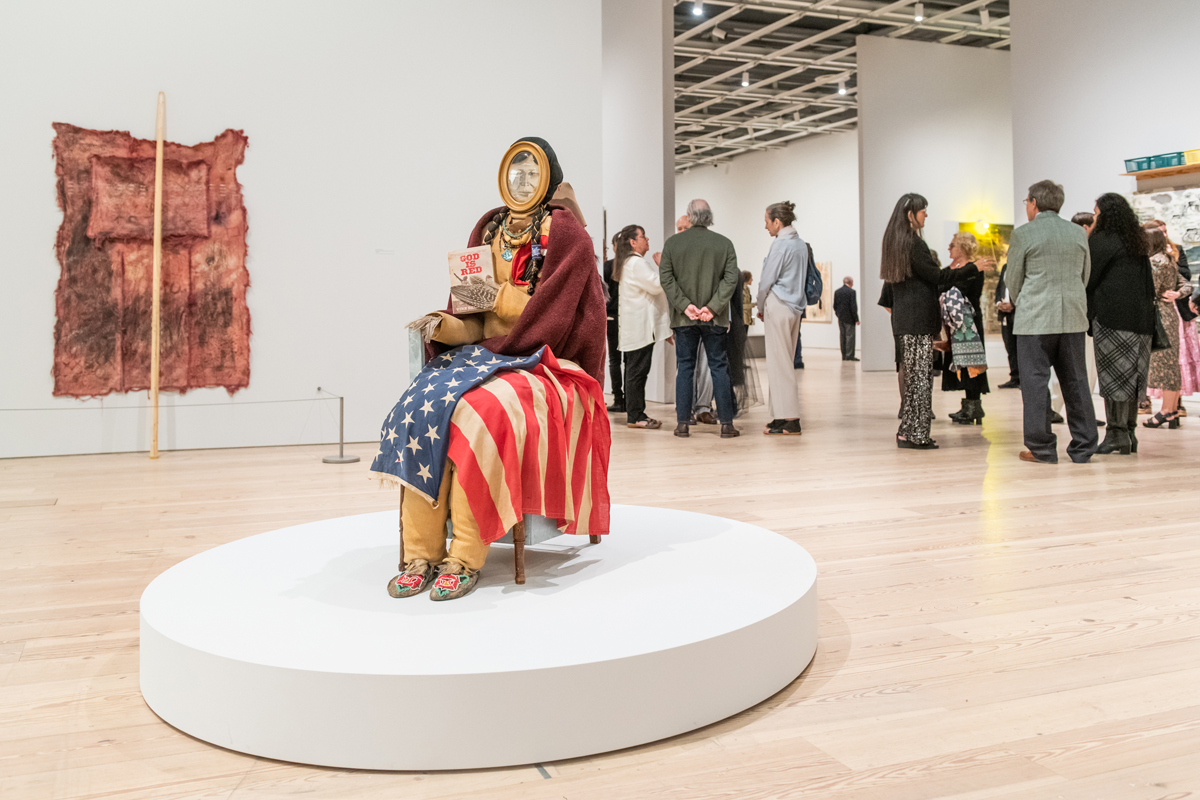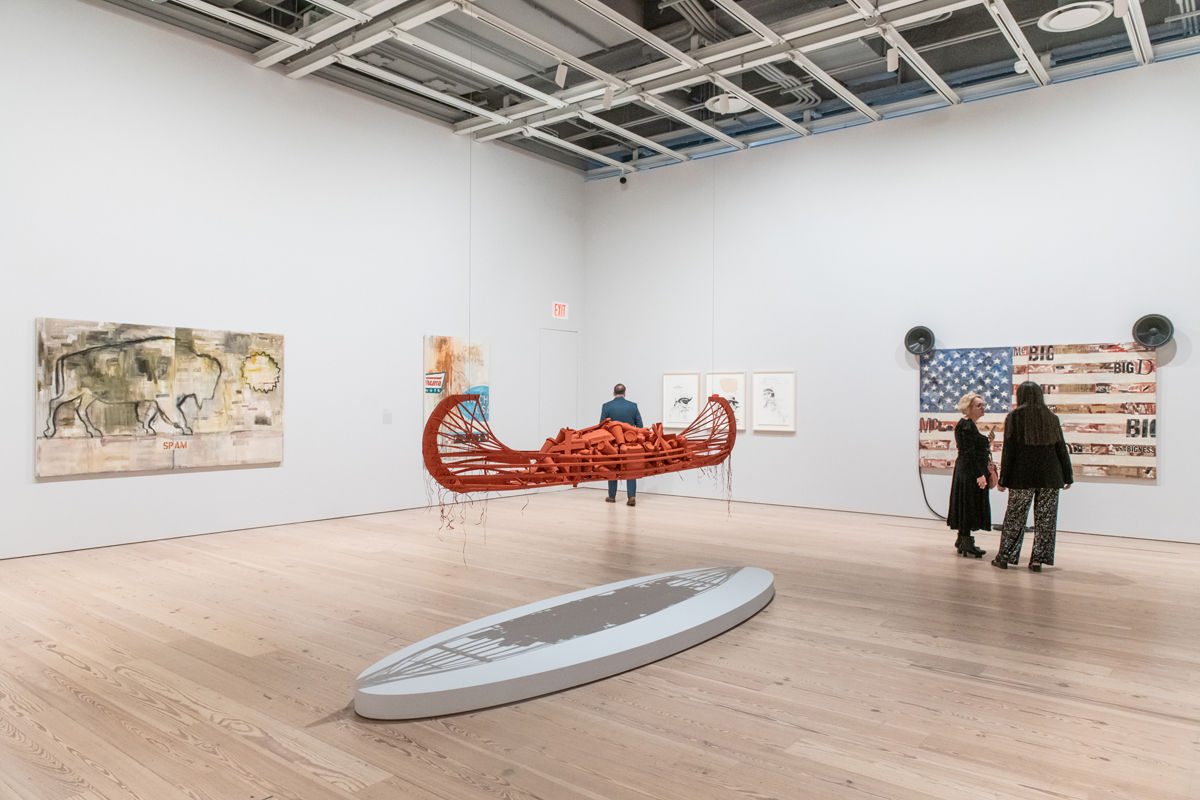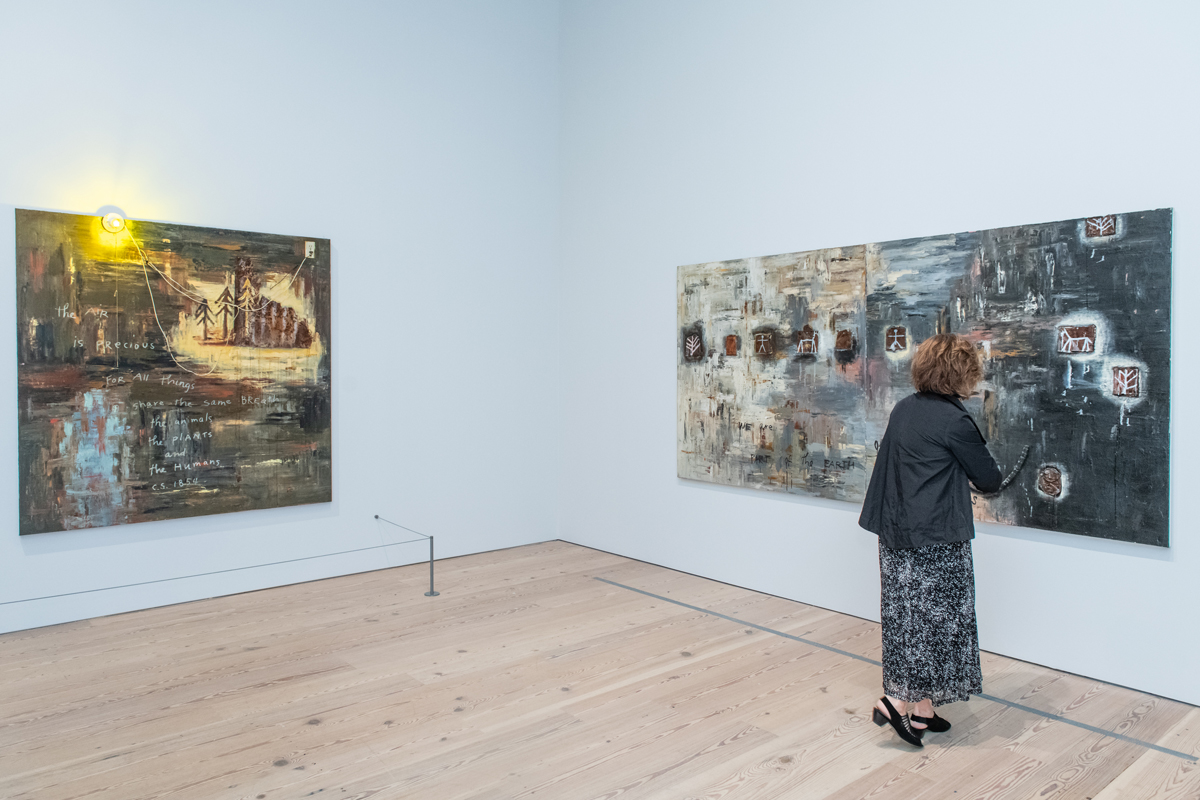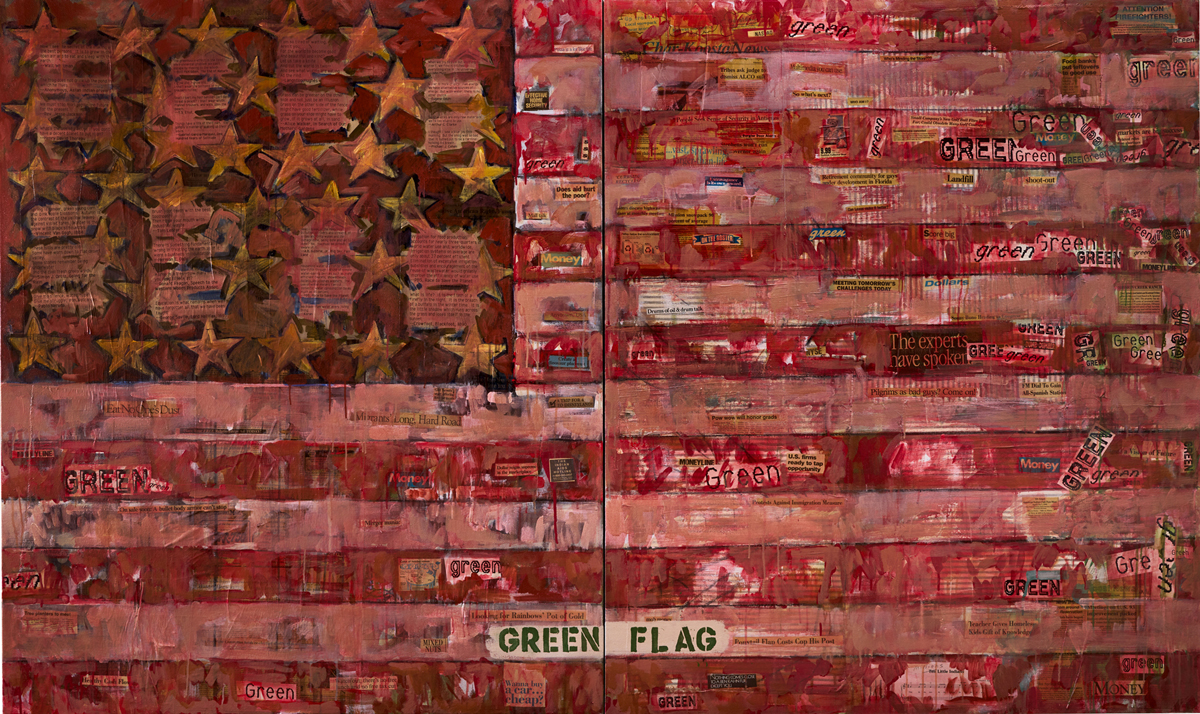 Aruna D’Souza
Aruna D’Souza
A sharp indictment of settler colonialism in the Whitney’s first retrospective of a Native American artist.

Jaune Quick-to-See Smith: Memory Map, installation view. Courtesy the Whitney Museum of American Art. Photo: Matthew Carasella. Pictured, center foreground: Indian Madonna Enthroned, 1974.
Jaune Quick-to-See Smith: Memory Map, organized by Laura Phipps with Caitlin Chaisson, Whitney Museum of American Art, 99 Gansevoort Street, New York City, through August 13, 2023
• • •
Among the more than one hundred thirty works in the Whitney Museum’s major retrospective of Jaune Quick-to-See Smith—the largest to date for the eighty-three-year-old artist, and the first of a Native American organized by the self-proclaimed museum of American art—is Indian Madonna Enthroned, from 1974. A life-size doll sitting in a chair, she sports braids adorned with leather thongs, animal skin, burlap leggings, a wool shawl, necklaces, beaded moccasins, and pheasant feathers for hands. Embedded in her chest, where her heart should be, is a dried ear of corn. Her face is composed of a framed drawing; another drawing, peeking out from the black fur of the hide on her back, suggests a baby—they nod to the way the long genocide of Native Americans has been accompanied by their entombment in museums (figuratively, in relation to art and culture, and literally, in relation to human remains). She uses a US flag as a lap blanket and, just behind her head, a piece of hide is marked “Property of BIA”—or Bureau of Indian Affairs, an agency established by the settler-colonial government to control and deracinate Indigenous people that is now part of the Department of the Interior, managed alongside national parks and wildlife refuges. And then, in her feather-hands, a sign of resistance: activist Vine Deloria Jr.’s God Is Red, a 1972 study of Native spiritual practices, which Christian churches, through mechanisms of assimilation including “boarding schools” (in Canada, “residential schools”), tried their damnedest to erase.

Jaune Quick-to-See Smith: Memory Map, installation view. Courtesy the Whitney Museum of American Art. Photo: Matthew Carasella.
Smith’s Madonna is a syncretic figure, acknowledging all the beliefs and histories, tender and violent by turns, to which the piece refers as part of contemporary Native experience. The artist, a member of the Confederated Salish and Kootenai nation who grew up on the Flathead Reservation in Montana and received her MA at the University of New Mexico in 1980, applies this syncretic approach to her formal choices as well. Drawing on Plains Indian craft traditions and modernist strategies of the ready-made and assemblage, the work exists in the same orbit as contemporaries like Marisol and Ed Kienholz while anticipating Jimmie Durham. His Self-Portrait of 1986 and, even more pointedly, Malinche of 1988–92 seem to borrow heavily from Smith’s Indian Madonna Enthroned. (Durham’s 2017 retrospective at the Whitney was, I suspect, intended to be the first of a Native American artist at the museum, until long-standing challenges to his claims of Cherokee ancestry were debated at the show’s earlier stop at the Walker Art Center; the Whitney ultimately stepped back from definitively identifying Durham as Indigenous in its presentation.)

Jaune Quick-to-See Smith: Memory Map, installation view. Courtesy the Whitney Museum of American Art. Photo: Matthew Carasella. Pictured, left to right: Sunlit (C.S. 1854), 1989; The Garden (C.S. 1854), 1989.
Over the course of her five-decade career, Smith has used a wide variety of tools—artmaking, activism, curating, education—to prevent the erasure of Native American people from the land, and thus from memory; she sees her work, as the exhibition title suggests, as “memory maps.” The idea that Native identity springs from a relationship to the land is beautifully demonstrated in a series of works dedicated to Chief Seattle (ca. 1790–1866), the nineteenth-century Suquamish and Duwamish leader who famously gave a speech to Isaac Stevens, the governor and superintendent of Indian Affairs of Washington Territory, in 1854 asking the new settler-colonial authority to respect Native ideas of environmental stewardship and responsibility. A fragment of Chief Seattle’s words—“We are part of the earth and it is part of us”—is painted onto Smith’s abstract oil diptych The Garden (C.S. 1854), from 1989. Here, rusty tin cans impressed with Southwest Indian–style petroglyphs, nails, and a snaking rubber tube are affixed to a ground whose rectilinear strokes move from dirty whites and yellows to dun browns, oxidized reds and oranges, and sooty blacks, creating a surface that evokes the consequences of ignoring Indigenous practices for centuries. In Sunlit (C.S. 1854), also from 1989, a yellow lightbulb replaces the sun, casting its chemical glow from the top edge of the canvas, while its electrical cord drapes down in a tangled mess, partially obscuring a small depiction of mountain and trees in an otherwise nonrepresentational field before plugging into a socket fixed in the picture’s upper-right corner. The paint handling in these pieces—along with Rain (C.S. 1854) from 1990, which uses silver spoons to suggest pelting drops of acid rain—echoes Abstract Expressionist brushwork even as Smith dismantles the blustery, bombastic, heroic American rhetoric that often adhered to that movement. Manifest Destiny seems especially nonsensical when all you end up doing is ruining the land you connived so hard to steal; likewise, the American avant-garde seems far less rebellious when it merely reiterates the colonial mythos of manly men and their sui generis creativity.

Jaune Quick-to-See Smith, Green Flag, 1995. Acrylic, paper, newspaper, fabric, charcoal, and graphite pencil on canvas, two panels, 60 × 100 inches overall. Photo: Jerry L. Thompson. © Jaune Quick-to-See Smith.
Smith’s postmodern jujitsu with art-historical sources is particularly apparent when she incorporates printed materials into her paintings of maps and flags—the connection to the work of Jasper Johns is unmistakable here. A diptych like Green Flag (1995) gains its force from a citational logic: like Johns, Smith has built up her canvas using scraps of newsprint and other textual collage elements combined with blocky painted strokes that drip down in places (though she uses acrylic instead of Johns’s encaustic). Strewn over a scrubby field of red are stenciled and typeset words—Green Flag and Green—despite the fact that the color green is conspicuously absent from the picture. The move recalls Johns’s paintings, such as Flag (1954–55), where signifier and signified clash and contradict. Johns’s goal was to suggest an opacity of meaning—to blur the line between image and object, to emphasize the thingness of the painting, to refuse reading in. Smith pointedly moves in the opposite direction: she uses text to incorporate political commentary, humor, and poetry, offering up a picture of the intersection of environmental devastation, capitalism, the silencing of Indigenous voices, and other factors that have led us to this moment of crisis. Among the flag’s stars are printed quotations from Pablo Neruda (“Give me silence, water, hope / Give me struggle, iron, volcanoes”) and Ronald Reagan (“A tree is a tree—how many more do you need to look at?”). The stripes, meanwhile, are overlaid with newspaper headlines and ad copy (“Money,” “Moneyline,” “Drums of oil & drum talk,” “Migrants’ long, hard road,” “Dollar reigns supreme in the marketplace,” “Does aid hurt the poor?” “The Indian AIDS hotline,” and so on). The urgency and level of political analysis Smith achieves here makes Johns’s work—the subject of a major two-museum retrospective at the Whitney and the Philadelphia Museum of Art in 2021–22—look tepid, puny, and minor in comparison. Smith refuses the aloofness of the white avant-garde in favor of something fierce and necessary—and, tragic to say, endlessly relevant for our time.
Aruna D’Souza is the 2022–23 W. W. Corcoran Professor of Social Engagement at the Corcoran School of Art and Design in Washington, DC and a contributor to the New York Times and 4Columns. She was awarded the Rabkin Prize for arts journalism in 2021.